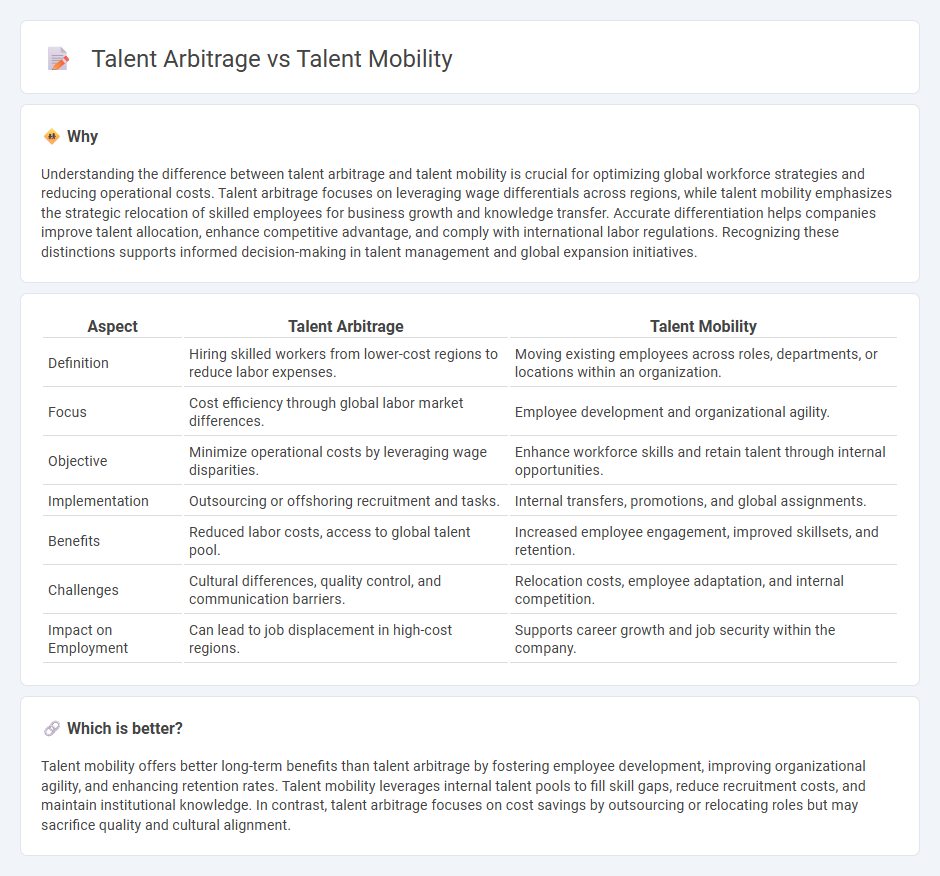
Talent arbitrage involves sourcing skilled professionals from regions with lower labor costs to optimize company expenses, while talent mobility focuses on relocating existing employees across geographic locations for strategic growth and knowledge transfer. Companies leveraging talent arbitrage can achieve competitive advantages through cost savings, whereas talent mobility enhances organizational agility and employee development. Discover how balancing talent arbitrage and talent mobility can transform your workforce strategy.
Why it is important
Understanding the difference between talent arbitrage and talent mobility is crucial for optimizing global workforce strategies and reducing operational costs. Talent arbitrage focuses on leveraging wage differentials across regions, while talent mobility emphasizes the strategic relocation of skilled employees for business growth and knowledge transfer. Accurate differentiation helps companies improve talent allocation, enhance competitive advantage, and comply with international labor regulations. Recognizing these distinctions supports informed decision-making in talent management and global expansion initiatives.
Comparison Table
| Aspect | Talent Arbitrage | Talent Mobility |
|---|---|---|
| Definition | Hiring skilled workers from lower-cost regions to reduce labor expenses. | Moving existing employees across roles, departments, or locations within an organization. |
| Focus | Cost efficiency through global labor market differences. | Employee development and organizational agility. |
| Objective | Minimize operational costs by leveraging wage disparities. | Enhance workforce skills and retain talent through internal opportunities. |
| Implementation | Outsourcing or offshoring recruitment and tasks. | Internal transfers, promotions, and global assignments. |
| Benefits | Reduced labor costs, access to global talent pool. | Increased employee engagement, improved skillsets, and retention. |
| Challenges | Cultural differences, quality control, and communication barriers. | Relocation costs, employee adaptation, and internal competition. |
| Impact on Employment | Can lead to job displacement in high-cost regions. | Supports career growth and job security within the company. |
Which is better?
Talent mobility offers better long-term benefits than talent arbitrage by fostering employee development, improving organizational agility, and enhancing retention rates. Talent mobility leverages internal talent pools to fill skill gaps, reduce recruitment costs, and maintain institutional knowledge. In contrast, talent arbitrage focuses on cost savings by outsourcing or relocating roles but may sacrifice quality and cultural alignment.
Connection
Talent arbitrage leverages the cost differentials of skilled labor across regions, enabling companies to optimize expenses by sourcing talent where it is most cost-effective. Talent mobility facilitates the transfer of skilled professionals across geographic and organizational boundaries, enhancing access to global talent pools. Together, talent arbitrage and mobility enable businesses to strategically deploy human capital to maximize efficiency and competitive advantage in the global labor market.
Key Terms
Internal Mobility
Talent mobility emphasizes internal movement of employees within an organization to maximize skill utilization, enhance career development, and retain top talent. Talent arbitrage typically involves leveraging global labor market differences to reduce costs by outsourcing or offshoring, which contrasts with the internal focus of talent mobility. Explore further to understand how internal mobility drives organizational agility and employee engagement.
Skill Utilization
Talent mobility emphasizes strategically relocating employees to maximize skill utilization by aligning their expertise with organizational needs across different locations. Talent arbitrage focuses on leveraging cost differences between regions to optimize labor expenses, often prioritizing financial savings over skill matching. Discover how optimizing skill utilization through talent mobility can enhance workforce effectiveness and business outcomes.
Labor Cost Optimization
Talent mobility enables organizations to strategically relocate employees to optimize labor costs by leveraging regional salary differentials and skills availability, boosting operational efficiency. Talent arbitrage focuses on hiring from lower-cost labor markets to reduce expenses, often prioritizing cost over employee development and retention. Explore deeper insights into how these strategies impact labor cost optimization and organizational growth.
Source and External Links
What Is Talent Mobility and How does it Benefit Companies - Talent mobility is the movement of employees within an organization through promotions, lateral moves, and cross-functional projects, enabling companies to improve satisfaction, productivity, and retention by providing clear career paths and continuous internal growth opportunities.
Talent Mobility - WERC - Talent mobility is a strategic workforce management approach ensuring the right skills are positioned at the right place and time, encompassing job rotations, transfers, international assignments, and remote work to develop employees, reduce costs, and maintain competitiveness in a globalized economy.
What Is Talent Mobility and How to Develop a Strategy - AIHR - Talent mobility facilitates internal employee movement by understanding skills and experiences, leading to improved job satisfaction, workforce agility, retention of top talent, and increased diversity within organizations.
 dowidth.com
dowidth.com